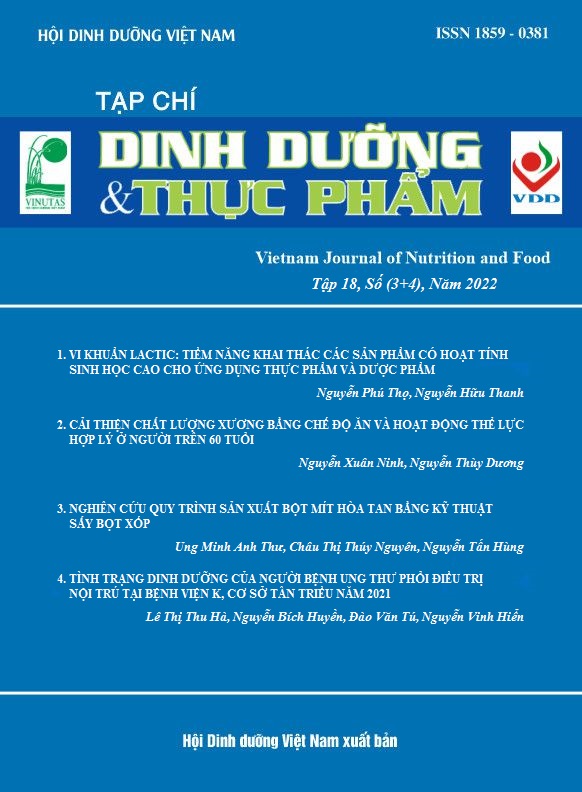LACTIC ACID BACTERIA: POTENTIAL FOR DISCOVERING HIGH BIOACTIVITY PRODUCTS FOR FOOD AND PHARMACEUTICAL APPLICATIONS
Main Article Content
Abstract
Lactic acid bacteria (LAB) are of great importance for their wide applications in the food and pharmaceutical industries. Bacteriocins and antifungal compounds as well as lactic acid are produced by LAB, which can be used as food preservatives. Furthermore, with their health-promoting properties, several probiotic strains derived from LAB have been exploited for applications in pharmaceuticals and functional foods. The enormous potential of LAB to produce bioactive substances such as exopolysaccharides, lipoteichoic acid, conjugated linoleic acid, etc., is expanding their industrial applications. To efficiently exploit LAB fermentation, however, the combination of fermentation and extraction processes must ensure the bioactivity stability of the fermentation products, which still remains a challenge.
Keywords
Bacteriocin, exopolysacharide, probiotic, Lactic acid bacteria
Article Details
References
2. Vinusha KS, Deepika K, Johnson TS, Agrawal GK, Rakwal R. RETRACTED: Proteomic studies on lactic acid bacteria: A review. Biochem. Biophys. Rep.. 2018;14:140-148.
3. Corona‐Hernandez R, Alvarez-Parrilla E, Lizardi-Mendoza J, Islas-Rubio A, De la Rosa L, Wall A. Structural stability and viability of microencapsulated probiotic bacteria: A review. Compr. Rev. Food Sci. F.. 2013;12.
4. Bosma E, Forster J, Nielsen A. Lactobacilli and pediococci as versatile cell factories – Evaluation of strain properties and genetic tools. Biotechnol. Adv.. 2017;35.
5. Wee Y-J, Kim J-N, Ryu H-W. Biotechnological production of lactic acid and its recent applications. Food Technol. Biotechnol.. 2006; 44.
6. Castillo Martinez FA, Balciunas EM, Salgado JM, Domínguez González JM, Converti A, Oliveira RPdS. Lactic acid properties, applications and production: A review. Trends Food Sci. Technol.. 2013; 30 (1):70-83.
7. And HC, Hoover DG. Bacteriocins and their food applications. Compr. Rev. Food Sci. F.. 2003;2 (3):82-100.
8. Zacharof MP, Lovitt RW. Bacteriocins produced by lactic acid bacteria a review article. APCBEE Procedia. 2012; 2:50-56.
9. Aleixandre-Tudó JL, Castelló-Cogollos L, Aleixandre JL, Aleixandre-Benavent R. Tendencies and challenges in worldwide scientific research on probiotics. Probiotics Antimicrob. Proteins. 2020;12 (3):785-797.
10. Sanders ME, Merenstein DJ, Reid G, Gibson GR, Rastall RA. Probiotics and prebiotics in intestinal health and disease: from biology to the clinic. Nat. Rev. Gastroenterol Hepatol.. 2019;16 (10):605-616.
11. Puebla-Barragán S. Forty-five-year evolution of probiotic therapy. Microbial Cell. 2019;6.
12. Moraes P, Perin L, Silva A, Nero L. Comparison of phenotypic and molecular tests to identify lactic acid bacteria. Brazilian J. Microbiol.. 2013;44:109-112.
13. García-Ruiz A, González de Llano D, Esteban-Fernández A, Requena T, Bartolomé B, Moreno-Arribas MV. Assessment of probiotic properties in lactic acid bacteria isolated from wine. Food Microbiol.. 2014;44:220-225.
14. Klewicki R, Klewicka E. Antagonistic activity of lactic acid bacteria as probiotic against selected bacteria of Enterobaceriacae family in the presence of polyols and their galactosyl derivatives. Biotechnol. Lett.. 2004;26:317-320.
15. Ozdemir O. Various effects of different probiotic strains in allergic disorders: An update from laboratory and clinical data. Clin. Exp. Immunol.. 2010;160:295-304.
16. Brown S, Santa Maria JP, Jr., Walker S. Wall teichoic acids of gram-positive bacteria. Annu. Rev. Microbiol.. 2013;67:313-336.
17. Villéger R, Saad N, Grenier K, Falourd X, Foucat L, Urdaci MC, Bressollier P, Ouk T-S. Characterization of lipoteichoic acid structures from three probiotic Bacillus strains: involvement of d-alanine in their biological activity. Antonie Van Leeuwenhoek. 2014;106 (4):693-706.
18. Ginsburg I. Role of lipoteichoic acid in infection and inflammation. Lancet Infect. Dis.. 2002;2:171-179.
19. Weill F, Cela E, Paz M, Ferrari A, Leoni J, Gonzalez Maglio D. Lipoteichoic acid from Lactobacillus rhamnosus GG as an oral photoprotective agent against UV-induced carcinogenesis. Br. J. Nutr.. 2012;109:1-10.
20. Morath S, Geyer A, Hartung T. Structure–function relationship of cytokine induction by lipoteichoic acid from Staphylococcus aureus. J. Exp. Med.. 2001;193:393-397.
21. Mays ZJ, Nair NU. Synthetic biology in probiotic lactic acid bacteria: At the frontier of living therapeutics. Curr. Opin. Biotechnol.. 2018;53:224-231.
22. Mora J, Montero-Zamora J, Barboza N, Rojas-Garbanzo C, Usaga J, Redondo-Solano M, Schroedter L, Olszewska-Widdrat A, López-Gómez J. Multi-product lactic acid bacteria fermentations: A review. Fermentation. 2020;6:23.
23. Lee J, Lee MH, Cho EJ, Lee S. High-yield methods for purification of α-linolenic acid from Perilla frutescens var. japonica oil. App. Biol. Chem.. 2016;59 (1):89-94.
24. Choi K, Jeon B, Kim B-C, Oh M-K, Um Y, Sang B-I. In situ biphasic extractive fermentation for hexanoic acid production from sucrose by Megasphaera elsdenii NCIMB 702410. Appl. Biochem. Biotechnol.. 2013;171.
25. Bertsch A, Roy D, LaPointe G. Enhanced exopolysaccharide production by Lactobacillus rhamnosus in Co-culture with Saccharomyces cerevisiae. Appl. Sci.. 2019;9:4026.
26. Yang Z, Suomalainen T, MÄYrÄ-MÄKinen A, Huttunen E. Antimicrobial activity of 2-pyrrolidone-5-carboxylic acid produced by lactic acid bacteria. J. Food Prot.. 1997;60 (7):786-794.
27. LeBlanc JG, Laiño J, Valle M, Vannini V, Van Sinderen D, Taranto M, Valdez G, Savoy G, Sesma F. B‐Group vitamin production by lactic acid bacteria – current knowledge and potential applications. J. Appl. Microbiol.. 2011;111:1297-1309.
Similar Articles
- Nguyễn Trọng Hưng, Vũ Thị Lan Phương, Phan Hướng Dương, NUTRITIONAL STATUS IN TYPE 2 DIABETES MELLITUS PATIENTS HOSPITALIZED AT THE NATIONAL HOSPITAL OF ENDOCRINOLOGY, 2019 - 2020 , Vietnam Journal of Nutrition & Food: Vol. 16 No. 2 (2020)
- Thi Ngoc Huyen TRINH, Thi Huong Lan NGUYEN, Huong Duong PHAN, Trong Hung NGUYEN, NUTRITIONAL STATUS IN TYPE 2 DIABETES MELLITUS INPATIENTS AT THE NATIONAL HOSPITAL OF ENDOCRINOLOGY, 2020 , Vietnam Journal of Nutrition & Food: Vol. 17 No. 1 (2021)
You may also start an advanced similarity search for this article.


